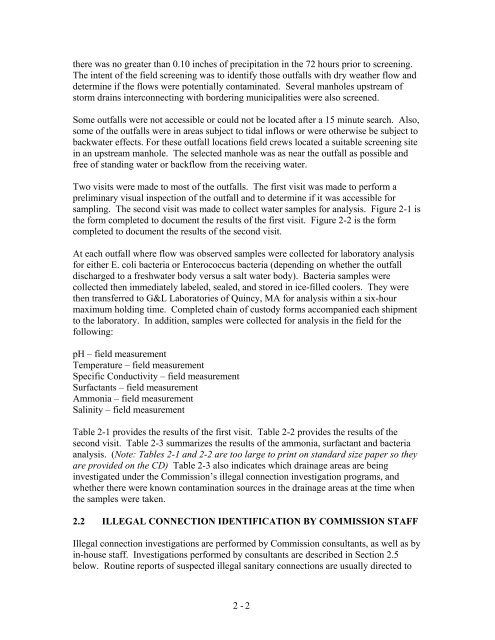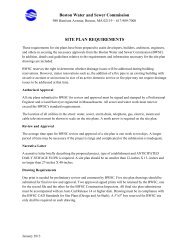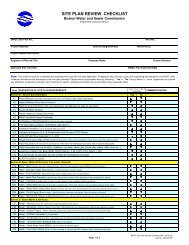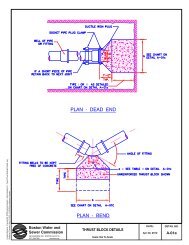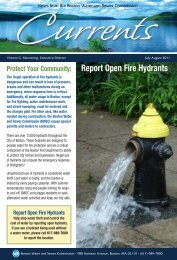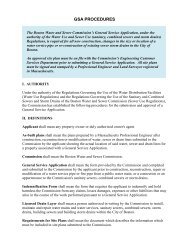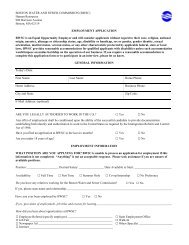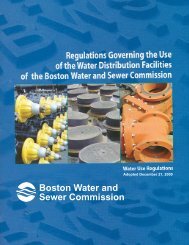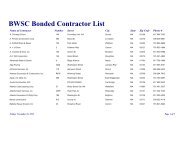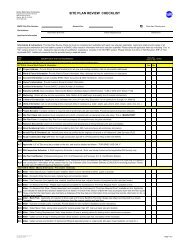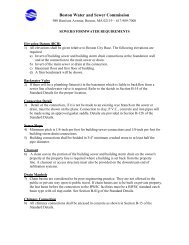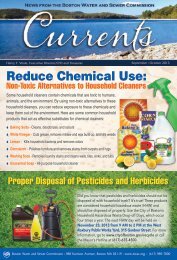2011 Stormwater Annual Report - Boston Water and Sewer ...
2011 Stormwater Annual Report - Boston Water and Sewer ...
2011 Stormwater Annual Report - Boston Water and Sewer ...
- No tags were found...
Create successful ePaper yourself
Turn your PDF publications into a flip-book with our unique Google optimized e-Paper software.
there was no greater than 0.10 inches of precipitation in the 72 hours prior to screening.The intent of the field screening was to identify those outfalls with dry weather flow <strong>and</strong>determine if the flows were potentially contaminated. Several manholes upstream ofstorm drains interconnecting with bordering municipalities were also screened.Some outfalls were not accessible or could not be located after a 15 minute search. Also,some of the outfalls were in areas subject to tidal inflows or were otherwise be subject tobackwater effects. For these outfall locations field crews located a suitable screening sitein an upstream manhole. The selected manhole was as near the outfall as possible <strong>and</strong>free of st<strong>and</strong>ing water or backflow from the receiving water.Two visits were made to most of the outfalls. The first visit was made to perform apreliminary visual inspection of the outfall <strong>and</strong> to determine if it was accessible forsampling. The second visit was made to collect water samples for analysis. Figure 2-1 isthe form completed to document the results of the first visit. Figure 2-2 is the formcompleted to document the results of the second visit.At each outfall where flow was observed samples were collected for laboratory analysisfor either E. coli bacteria or Enterococcus bacteria (depending on whether the outfalldischarged to a freshwater body versus a salt water body). Bacteria samples werecollected then immediately labeled, sealed, <strong>and</strong> stored in ice-filled coolers. They werethen transferred to G&L Laboratories of Quincy, MA for analysis within a six-hourmaximum holding time. Completed chain of custody forms accompanied each shipmentto the laboratory. In addition, samples were collected for analysis in the field for thefollowing:pH – field measurementTemperature – field measurementSpecific Conductivity – field measurementSurfactants – field measurementAmmonia – field measurementSalinity – field measurementTable 2-1 provides the results of the first visit. Table 2-2 provides the results of thesecond visit. Table 2-3 summarizes the results of the ammonia, surfactant <strong>and</strong> bacteriaanalysis. (Note: Tables 2-1 <strong>and</strong> 2-2 are too large to print on st<strong>and</strong>ard size paper so theyare provided on the CD) Table 2-3 also indicates which drainage areas are beinginvestigated under the Commission’s illegal connection investigation programs, <strong>and</strong>whether there were known contamination sources in the drainage areas at the time whenthe samples were taken.2.2 ILLEGAL CONNECTION IDENTIFICATION BY COMMISSION STAFFIllegal connection investigations are performed by Commission consultants, as well as byin-house staff. Investigations performed by consultants are described in Section 2.5below. Routine reports of suspected illegal sanitary connections are usually directed to2 - 2


